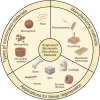Engineered biomimetic micro/nano-materials for tissue regeneration
- PMID: 37469449
- PMCID: PMC10352664
- DOI: 10.3389/fbioe.2023.1205792
Engineered biomimetic micro/nano-materials for tissue regeneration
Abstract
The incidence of tissue and organ damage caused by various diseases is increasing worldwide. Tissue engineering is a promising strategy of tackling this problem because of its potential to regenerate or replace damaged tissues and organs. The biochemical and biophysical cues of biomaterials can stimulate and induce biological activities such as cell adhesion, proliferation and differentiation, and ultimately achieve tissue repair and regeneration. Micro/nano materials are a special type of biomaterial that can mimic the microstructure of tissues on a microscopic scale due to its precise construction, further providing scaffolds with specific three-dimensional structures to guide the activities of cells. The study and application of biomimetic micro/nano-materials have greatly promoted the development of tissue engineering. This review aims to provide an overview of the different types of micro/nanomaterials, their preparation methods and their application in tissue regeneration.
Keywords: biomimetic microstructure; micro/nano-materials; regeneration; repair; tissue engineering.
Copyright © 2023 Han, Meng, Xie, Li, Hu, Chen, Li and Han.
Conflict of interest statement
The authors declare that the research was conducted in the absence of any commercial or financial relationships that could be construed as a potential conflict of interest.
Figures










Similar articles
-
From Soft to Hard Biomimetic Materials: Tuning Micro/Nano-Architecture of Scaffolds for Tissue Regeneration.Micromachines (Basel). 2022 May 16;13(5):780. doi: 10.3390/mi13050780. Micromachines (Basel). 2022. PMID: 35630247 Free PMC article. Review.
-
Living nano-micro fibrous woven fabric/hydrogel composite scaffolds for heart valve engineering.Acta Biomater. 2017 Mar 15;51:89-100. doi: 10.1016/j.actbio.2017.01.051. Epub 2017 Jan 18. Acta Biomater. 2017. PMID: 28110071
-
Sustained release of basic fibroblast growth factor in micro/nanofibrous scaffolds promotes annulus fibrosus regeneration.Acta Biomater. 2023 Aug;166:241-253. doi: 10.1016/j.actbio.2023.05.034. Epub 2023 May 24. Acta Biomater. 2023. PMID: 37230436
-
Biomimetic Aspects of Restorative Dentistry Biomaterials.Biomimetics (Basel). 2020 Jul 15;5(3):34. doi: 10.3390/biomimetics5030034. Biomimetics (Basel). 2020. PMID: 32679703 Free PMC article. Review.
-
Integrating biologically inspired nanomaterials and table-top stereolithography for 3D printed biomimetic osteochondral scaffolds.Nanoscale. 2015 Sep 7;7(33):14010-22. doi: 10.1039/c5nr03425f. Epub 2015 Aug 3. Nanoscale. 2015. PMID: 26234364 Free PMC article.
Cited by
-
Advances in Molecular and Genetic Technologies and the Problems Related to Their Application in Personalized Medicine.J Pers Med. 2024 May 23;14(6):555. doi: 10.3390/jpm14060555. J Pers Med. 2024. PMID: 38929775 Free PMC article. Review.
-
Tissue Engineering and Regenerative Medicine: Perspectives and Challenges.MedComm (2020). 2025 Apr 24;6(5):e70192. doi: 10.1002/mco2.70192. eCollection 2025 May. MedComm (2020). 2025. PMID: 40290901 Free PMC article. Review.
-
In vivo biocompatibility testing of nanoparticle-functionalized alginate-chitosan scaffolds for tissue engineering applications.Front Bioeng Biotechnol. 2023 Nov 23;11:1295626. doi: 10.3389/fbioe.2023.1295626. eCollection 2023. Front Bioeng Biotechnol. 2023. PMID: 38076436 Free PMC article.
-
Cardiac tissue engineering: an emerging approach to the treatment of heart failure.Front Bioeng Biotechnol. 2024 Aug 15;12:1441933. doi: 10.3389/fbioe.2024.1441933. eCollection 2024. Front Bioeng Biotechnol. 2024. PMID: 39211011 Free PMC article. Review.
-
3D Printing in Nasal Reconstruction: Application-Based Evidence on What Works, When, and Why.Biomedicines. 2025 Jun 11;13(6):1434. doi: 10.3390/biomedicines13061434. Biomedicines. 2025. PMID: 40564153 Free PMC article. Review.
References
-
- Admane P., Gupta A. C., Jois P., Roy S., Chandrasekharan Lakshmanan C., Kalsi G., et al. (2019). Direct 3D bioprinted full-thickness skin constructs recapitulate regulatory signaling pathways and physiology of human skin. Bioprinting 15, 00051. 10.1016/j.bprint.2019.e00051 - DOI
Publication types
LinkOut - more resources
Full Text Sources

